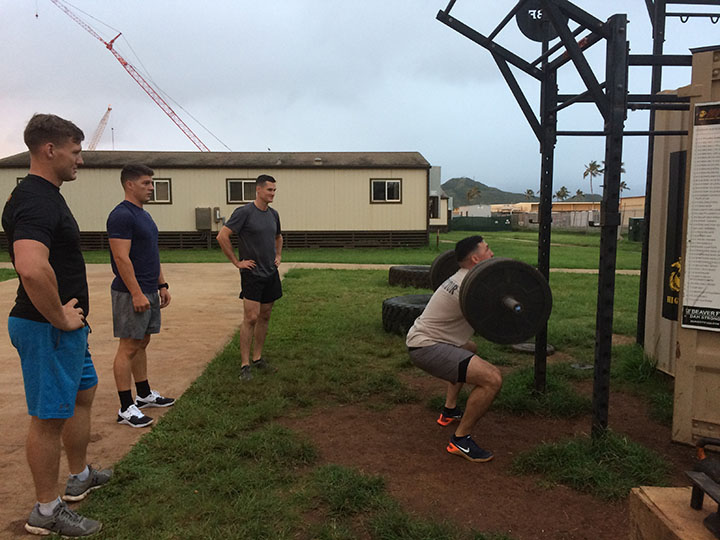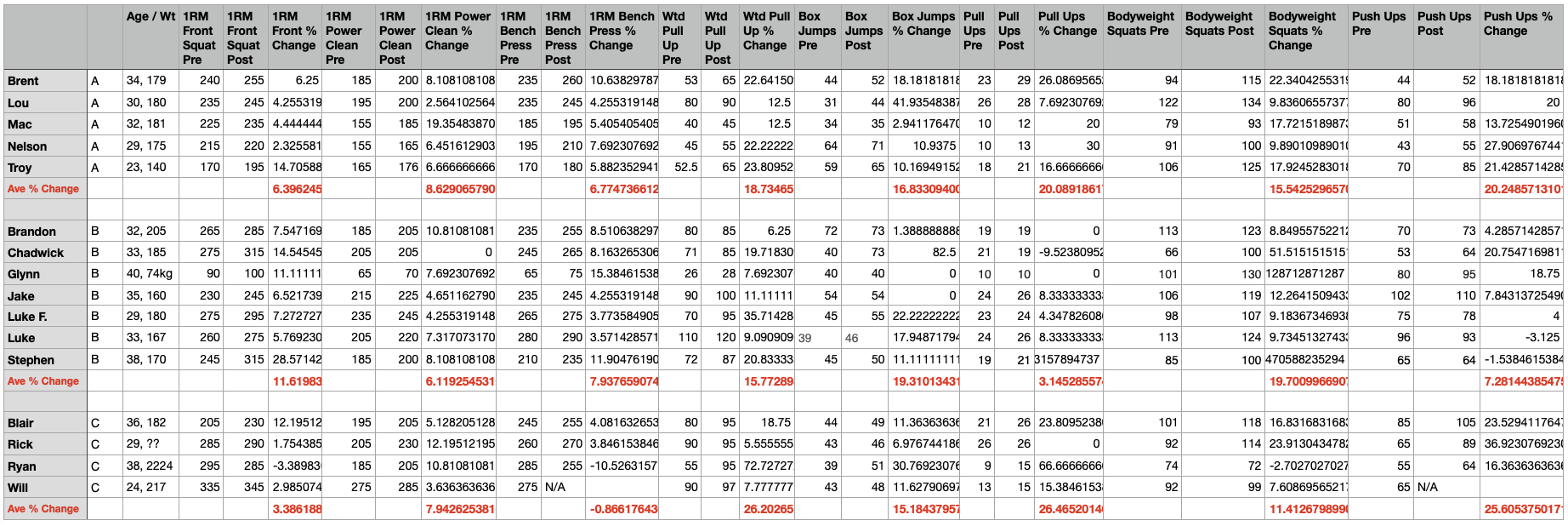By Rob Shaul, Founder
BLUF
Remote lab rats were able to increase both 1RM Strength and Bodyweight Strength concurrently across several events, but exercise scheduling differences between groups of lab rats proved inconclusive as to which would increase assessed exercises the most.
Background and Study Design
We conducted a 3.5-week Mini-Study using remote lab rats to test:
- Is effectively and efficiently training max effort strength and bodyweight strength endurance possible?
- Is there a difference in Group performance based on the weekly training schedule?
Sixteen remote lab rats completed this 3.5 week mini-study, 5x in Group A, 7x in Group B, and 4x in Group C. The programming consisted of completely assessment-based barbell strength and bodyweight strength work.
The difference between groups was scheduling.
Group A Schedule:
- Mon: Front Squat, Bench Press, Box Jumps, Pull Ups
- Tue: Power Clean, Wtd Pull Ups, Bodyweight, Push Ups
- Wed: Total Rest
- Thurs: Front Squat, Bench Press, Box Jumps, Pull Ups
- Fri: Power Clean, Wtd Pull Ups, Bodyweight, Push Ups
Group B Schedule:
- Mon: Front Squat, Bench Press, Bodyweight Squats, Push Ups
- Tue: Power Clean, Wtd Pull Ups, Box Jumps, Pull Ups
- Wed: Total Rest
- Thurs: Front Squat, Bench Press, Bodyweight Squats, Push Ups
- Fri: Power Clean, Wtd Pull Ups, Box Jumps, Pull Ups
Group C Schedule:
- Mon: Front Squat, Bench Press, Power Clean, Wtd Pull Ups
- Tue: Bodyweight Squats, Push Ups, Box Jumps, Pull Ups
- Wed: Total Rest
- Mon: Front Squat, Bench Press, Power Clean, Wtd Pull Ups
- Tue: Bodyweight Squats, Push Ups, Box Jumps, Pull Ups
Max effort assessments were completed at the beginning and end of the cycle for these exercises/events:
(1) 1 Repetition Maximum (1RM) Front Squat
(2) 1RM Bench Press
(3) 1RM Power Clean
(4) 1RM Weighted Pull Up
(5) Max Rep Pull Ups
(6) Max Rep 2 Minute Box Jumps @ 20/24″ Box
(7) Max Rep Bodyweight Squats in 3 Minutes
(8) Max Rep Push Ups in 2 Minutes
The lab rats were not allowed to complete any other fitness training during the 3-week study period. They were allowed to complete active recreation on the weekends.
At the end of the 3 weeks, the lab rats re-completed the 1RM and Bodyweight Strength efforts. The results from the pre and post cycle assessments were then compared.
Results and Discussion
Below are the individual lab rat results.
Below is the overall 1RM and Bodyweight strength improvement for all 3 groups:
All groups saw 1RM strength and bodyweight strength endurance improvements following this program for 7 out of 8 assessments. Group C saw an average decline in 1RM Bench Press improvement.
However, the data does not point to one scheduling approach as a significant advantage over any other.
The attrition for this study was significant. Sixteen lab rats completed the programming, but 22 did not. Generally, we’ll see a 40-50% attrition rate. We’re not sure why the attrition rate for this mini-study was higher than average. It could be as simple as the onset of Summer and the decline of Covid restrictions caused people to take time off from training, but we’re not sure.
Next Steps?
We were pleased to see the overall dual gains in 1RM strength and bodyweight strength endurance from this mini-study, which helps validate the focus of MTI’s progressions. The bodyweight strength endurance improvement was especially impressive.
However, because we were not able to see any significant difference in performance based on scheduling, it’s not clear how to improve this performance.
One unforeseen result from the study was the significant increases in bodyweight strength performance for most groups. This raises an interesting question …. does concurrently training 1RM strength with bodyweight strength increase bodyweight strength improvement?
Perhaps a topic for a future mini-study….
Questions? Email rob@mtntactical.com
Comments? Please comment below.
STAY UPDATED
Sign-up for our BETA newsletter. Training tips, research updates, videos and articles - and we’ll never sell your info.



